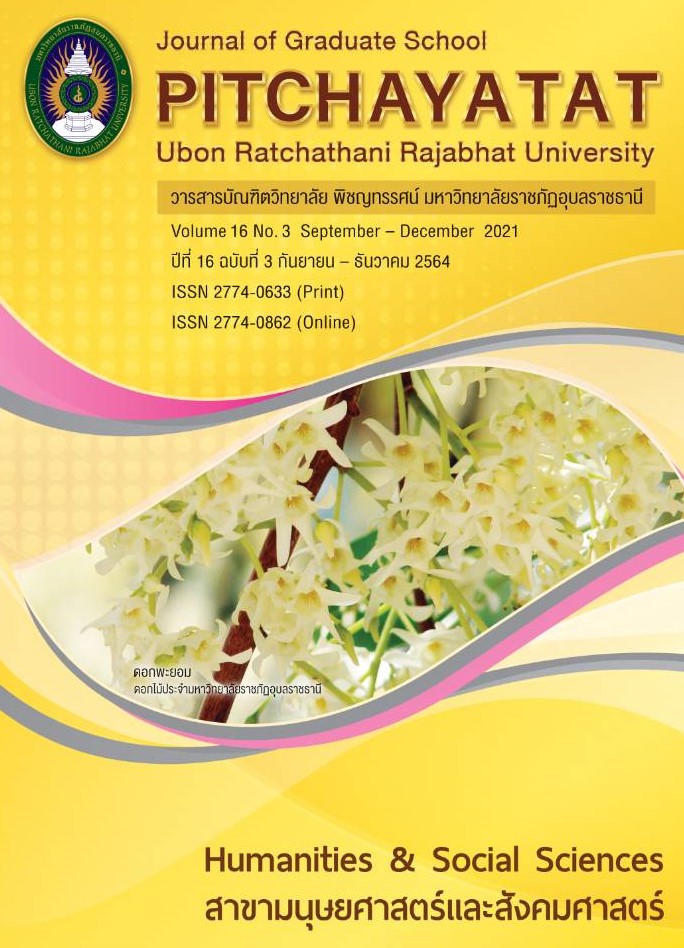ศักยภาพอาหารท้องถิ่นเพื่อสร้างความได้เปรียบด้านการท่องเที่ยว เขตอำเภอเมือง จังหวัดอุบลราชธานี
คำสำคัญ:
การท่องเที่ยวเชิงอาหาร, อาหารท้องถิ่น, ศักยภาพ, ความได้เปรียบบทคัดย่อ
งานวิจัยนี้มีวัตถุประสงค์เพื่อศึกษาศักยภาพของอาหารท้องถิ่นจังหวัดอุบลราชธานี ศึกษาพฤติกรรมผู้บริโภคที่มีต่ออาหารท้องถิ่นจังหวัดอุบลราชธานี และเสนอแนวทางการส่งเสริมพัฒนาอาหารท้องถิ่นอำเภอเมืองจังหวัดอุบลราชธานี เป็นการวิจัยแบบผสมผสาน เครื่องมือในการวิจัย คือ แบบสอบถามสำหรับประชากรในท้องถิ่น จำนวน 400 คน และสัมภาษณ์เชิงลึกตัวแทนที่เป็นผู้ประการอาหารท้องถิ่นจำนวน 5 ร้าน สถิติที่ใช้ได้แก่ ร้อยละ ค่าเฉลี่ย และส่วนเบี่ยงเบนมาตรฐาน
ผลการศึกษาพบว่า
กลุ่มตัวอย่างส่วนใหญ่คิดว่าความคุ้มค่าของราคามีศักยภาพมากที่สุดคือ ราคามีความเหมาะสมกับคุณภาพรองลงมา ได้แก่ ด้านคุณภาพของอาหารมีรสชาติอาหารที่อร่อย ด้านอัตลักษณ์อาหารท้องถิ่นมีการนำวัตถุดิบในท้องถิ่นมาเป็นส่วนประกอบ ด้านลักษณะของร้านอาหารท้องถิ่น มีการตกแต่งร้านและสร้างบรรยากาศของร้านได้น่าสนใจ ส่วนด้านลักษณะของผู้ให้บริการควรต้องมีการปรับปรุงให้ดียิ่งขึ้น เพื่อให้มีความพร้อมในการให้บริการ การท่องเที่ยวเชิงอาหารจึงเป็นสิ่งสำคัญที่ช่วยสนับสนุนการท่องเที่ยวให้เกิดการพัฒนา อีกทั้งเป็น การช่วยสนับสนุน และประชาสัมพันธ์วัฒนธรรมท้องถิ่นนั้น ๆ ในขณะเดียวกันก็เป็นการยกระดับและช่วยเพิ่มมูลค่าร้านอาหารท้องถิ่นให้มีศักยภาพ รวมถึงเป็นการสร้างภาพลักษณ์อาหารท้องถิ่นให้เป็นที่รู้จักมากยิ่งขึ้นอีกด้วย ผู้วิจัยจึงได้เสนอแนวทางในการส่งเสริมศักยภาพอาหารท้องถิ่น คือควรมีการสร้างอัตลักษณ์โดยนำภูมิปัญญาท้องถิ่นเข้ามาเป็นส่วนหนึ่งเพื่อสร้างความแตกต่าง มีการจัดเส้นทางการท่องเที่ยวที่เชื่อมโยงกับร้านอาหารเพื่อให้นักท่องเที่ยวได้มีโอกาสสัมผัสกับอาหารท้องถิ่นได้มากยิ่งขึ้น
เอกสารอ้างอิง
กชกร จุลศิลป์. กลยุทธ์การจัดการการตลาดเพื่อส่งเสริมการท่องเที่ยวเชิงอาหารของนักท่องเที่ยวชาวไทยในจังหวัดพระนครศรีอยุธยา. วิทยานิพนธ์ศิลปศาสตรมหาบัณฑิต สาขาวิชาการจัดการท่องเที่ยวแบบบูรณาการ สถาบันบัณฑิตพัฒนบริหารศาสตร์, 2561.
เจริญชัย เอกไพศาล, วรวุฒิ ปัญญาภู และวริศ เชาวนศิลป์. “ภาพลักษณ์การท่องเที่ยวเชิงอาหารของประเทศไทยผ่านมุมจากผู้ให้บริการ,” วารสารบริหารธุรกิจและสังคมศาสตร์. 2, 3 (กันยายน–ธันวาคม 2562) : 37–59.
เณรัญชรา กิจวิกรานต์. ภาพลักษณ์อาหารไทย การรับรู้คุณภาพอาหารไทยและแนวโน้มพฤติกรรม การท่องเที่ยวเชิงอาหารของนักท่องเที่ยวชาวต่างชาติ. วารสารวิชาการการท่องเที่ยวไทยนานาชาติ. 10(12) (มกราคม–มิถุนายน 2557): 55-74.
ท่องเที่ยวและกีฬา, กระทรวง (2563). สรุปรายได้และค่าใช้จ่ายการท่องเที่ยว ครั้งที่ 1/2562. ออนไลน์ 2563 อ้างเมื่อ (2564). จากhttps://www.mots.go.th/more_news.php?cid=528&filename=index
นันทิยา ตันตราสืบ. รูปแบบการท่องเที่ยวเชิงอาหารพื้นถิ่นเชิงสร้างสรรค์ในจังหวัดเชียงใหม่. วิทยานิพนธ์ปรัชญาดุษฎีบัณฑิต สาขาวิชาการจัดการการท่องเที่ยว มหาวิทยาลัยพะเยา, 2561
พิสมัย สุตะวงศ์. ปัจจัยแรงจูงใจของนักท่องเที่ยวกลุ่มเจนเนอเรชั่นวายในการท่องเที่ยวเชิงอาหารพื้นเมืองในจังหวัดเชียงราย. การค้นคว้าอิสระบริหารธุรกิจมหาบัณฑิต สาขาวิชาบริหารธุรกิจ มหาวิทยาลัยแม่ฟ้าหลวง, 2561
คณะกรรมการพัฒนาเศรษฐกิจและสังคมแห่งชาติ, สำนักงานคณะกรรมการแห่งชาติ, 2563. แผนพัฒนาเศรษฐกิจและสังคมแห่งชาติ ฉบับที่ 12 (พ.ศ. 2560 - 2564). กรุงเทพฯ: 2563.
หทัยชนก ฉิมบ้านไร่. ศักยภาพอาหารพื้นเมืองและแนวทางการส่งเสริมการท่องเที่ยวผ่านอาหารพื้นเมืองจังหวัดน่าน. วิทยานิพนธ์ศิลปศาสตรมหาบัณฑิต สาขาวิชาการจัดการการท่องเที่ยวแบบบูรณาการสถาบันบัณฑิตพัฒนบริหารศาสตร์, 2558.
Dann, Graham M.S. Tourist Motivation: An Appraisal. Annals of Tourism Research. 8, 2 (October 1981): 187-219
Cohen, E., and N. Avieli. “Food in Tourism Attraction and Impediment,” Annals of Tourism Research. 31, 4 (February 2004): 755-778.
Du Rand, G. E. and Heath, E. “Towards a framework for food tourism as an element of destination marketing,” Current Issues in Tourism. 9, 3 (2006): 206-234.
Hall, C.M. Wine food and tourism marketing. New York: Routledge, 2003.
Krejcie, R. V. and D. W. Morgan. “Determining Sample Size for Research Activities,” Educational and Psychological Measurement. 30, 3 (October 1970): 607-610.
Long, L. (ed.). Culinary Tourism: Food, Eating and Otherness. Lexington: University of Kentucky Press, 2003.
Seo, S. et al. “Influence of informational and experiential familiarity on image of local foods,” International Journal of Hospitality Management. 34, 1 (2015): 295–308.
Tinsley, H. E. A., and B.D. Eldredge. “Psychological benefits of leisure participation: A taxonomy of leisure activities based on their need-gratifying properties,” Journal of Counseling Psychology. 42, 2 (2013): 123–132.
Uysal, M. and L.E.R. Hagan. Motivation of Pleaseure travel and Tourism. In M.A.O. Khan, T. Var&Van Nostrand Reinhold, 1993.
ดาวน์โหลด
เผยแพร่แล้ว
รูปแบบการอ้างอิง
ฉบับ
ประเภทบทความ
สัญญาอนุญาต
ลิขสิทธิ์ (c) 2021 วารสารบัณฑิตวิทยาลัย พิชญทรรศน์ มหาวิทยาลัยราชภัฏอุบลราชธานี

อนุญาตภายใต้เงื่อนไข Creative Commons Attribution-NonCommercial-NoDerivatives 4.0 International License.
บทความทุกเรื่องได้รับการตรวจความถูกต้องทางวิชาการโดยผู้ทรงคุณวุฒิภายนอกอย่างน้อย 2 คน ความคิดเห็นในวารสารบัณฑิตวิทยาลัย พิชญทรรศน์ มหาวิทยาลัยราชภัฏอุบลราชธานี เป็นความคิดเห็นของผู้เขียนมิใช่ความคิดเห็นของผู้จัดทำ จึงมิใช่ ความรับผิดชอบของบัณฑิตวิทยาลัย มหาวิทยาลัยราชภัฏอุบลราชธานี และบทความในวารสารบัณฑิตวิทยาลัย พิชญทรรศน์ มหาวิทยาลัยราชภัฏอุบลราชธานี สงวนสิทธิ์ตามกฎหมายไทย การจะนำไปเผยแพร่ต้องได้รับอนุญาตเป็นลายลักษณ์อักษรจากกองบรรณาธิการ






